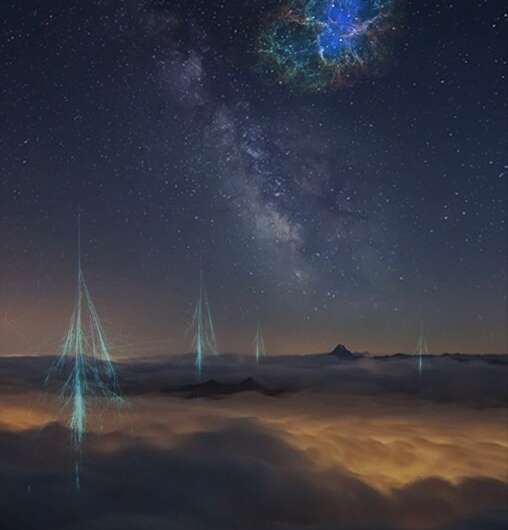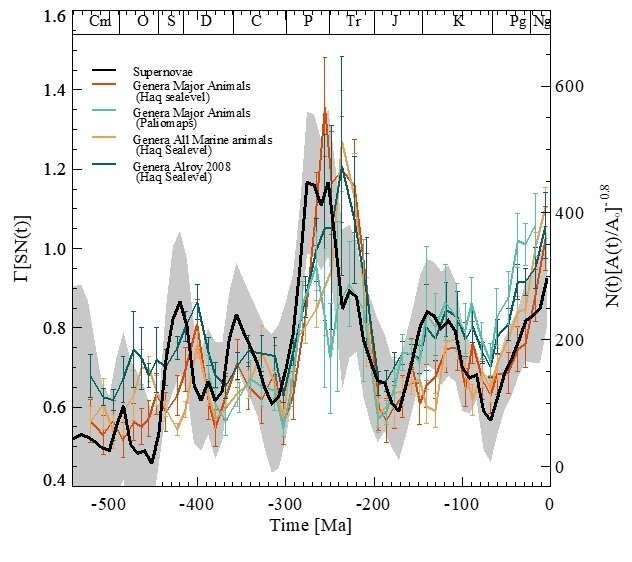This article has been reviewed according to Science X's editorial process and policies. Editors have highlighted the following attributes while ensuring the content's credibility:
fact-checked
peer-reviewed publication
trusted source
proofread
A persistent influence of supernovae on biodiversity

The number of exploding stars (supernovae) has significantly influenced marine life's biodiversity during the last 500 million years. This is the essence of a new study published in Ecology and Evolution by Henrik Svensmark, DTU space.
Extensive studies of the fossil record have shown that the diversity of life forms has varied significantly over geological time, and a fundamental question of evolutionary biology is which processes are responsible for these variations.
The new study reveals a major surprise: The varying number of nearby exploding stars (supernovae) closely follows changes in marine genera (the taxonomic rank above species) biodiversity during the last 500 million years. The agreement appears after normalizing the marine diversity curve by the changes in shallow marine areas along the continental coasts.
Shallow marine shelves are relevant since most marine life lives in these areas, and changes in shelf areas open new regions where species can evolve. Therefore, changes in available shallow areas influence biodiversity.
"A possible explanation for the supernova-diversity link is that supernovae influence Earth's climate," says Henrik Svensmark, author of the paper and senior researcher at DTU Space.
"A high number of supernovae leads to a cold climate with a large temperature difference between the equator and polar regions. This results in stronger winds, ocean mixing, and transportation of life-essential nutrients to the surface waters along the continental shelves."

The paper concludes that supernovae are vital for primary bioproductivity by influencing the transport of nutrients. Gross primary bioproductivity provides energy to the ecological systems, and speculations have suggested that changes in bioproductivity may influence biodiversity. The present results are in agreement with this hypothesis.
"The new evidence points to a connection between life on Earth and supernovae, mediated by the effect of cosmic rays on clouds and climate," says Henrik Svensmark.
When heavy stars explode, they produce cosmic rays, which are elementary particles with enormous energies. Cosmic rays travel to our solar system, where some end their journey by colliding with Earth's atmosphere. Previous studies by Henrik Svensmark and colleagues referenced below show that they become the primary source of ions help form and grow aerosols required in cloud formation.
Since clouds can regulate the solar energy reaching Earth's surface, the cosmic-ray-aerosol-cloud influences climate. Evidence shows substantial climate shifts when the intensity of cosmic rays changes by several hundred percent over millions of years.
More information: Henrik Svensmark, A persistent influence of supernovae on biodiversity over the Phanerozoic, Ecology and Evolution (2023). DOI: 10.1002/ece3.9898
Henrik Svensmark, Supernova Rates and Burial of Organic Matter, Geophysical Research Letters (2022). DOI: 10.1029/2021GL096376
Svensmark, H. and Friis-Christensen, E., Variation of Cosmic Ray Flux and Global Cloud Coverage -A missing Link in Solar-Climate Relationships, Journal of Atmospheric and Terrestrial Physics, 59, 1225, (1997)
Nir J. Shaviv et al, The Phanerozoic climate, Annals of the New York Academy of Sciences (2022). DOI: 10.1111/nyas.14920
Henrik Svensmark, Evidence of nearby supernovae affecting life on Earth, Monthly Notices of the Royal Astronomical Society (2012). DOI: 10.1111/j.1365-2966.2012.20953.x
Journal information: Monthly Notices of the Royal Astronomical Society , Geophysical Research Letters , Ecology and Evolution
Provided by Technical University of Denmark





















